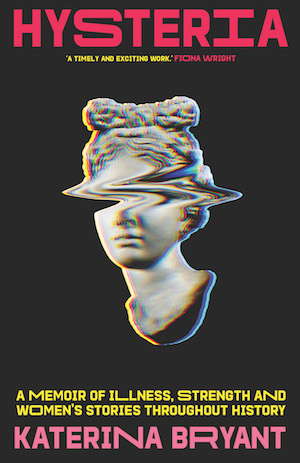Hysteria opens with a scene from a supermarket, where Katerina Bryant is shopping for groceries with her boyfriend, Mathew. As she pushes the trolley through the fruit and vegetable section, Bryant’s head ‘begins to rush’. She experiences a dissociative episode, like she’s slipped into a parallel dimension where everything is strange and unfamiliar – the snail-like mushrooms, the open-mouthed fish and the colourful packets of food. ‘This is what it’s like to go mad,’ she thinks.
Hysteria is the story of Bryant’s illness – her attempt to make sense of her symptoms, secure a diagnosis and, hopefully, recover. It is also an examination of the nature of illness and a meticulously researched literary and historical analysis of the condition once known as hysteria, a much-disputed assortment of symptoms that predominantly afflicted women. ‘Hysteria’ is an outdated term but ‘its legacy remains when women enter the waiting room,’ Bryant writes. ‘Sick women are still told by medical professionals and bystanders alike how well and happy they might be if they drink water, try yoga, exercise more, sleep well, take melatonin and maybe even smile.’
Bryant uses the tools she has at her disposal as a writer in her quest to understand her illness better.
First, she tries to ‘read her way to an answer’. ‘That’s always been my way; reading can solve the confusion of the world around me – even if it’s Googling ambiguous movie endings,’ she writes. And, indeed, she trawls the internet for answers, but her reading list extends far beyond WebMD.
Hysteria brims with literary references high and low, which Bryant uses to situate her experience in a broader historical and cultural context. There’s Susan Sontag’s Illness as a Metaphor; quotes from Nausea by Jean-Paul Sartre; a reference to Rat Race, a 2001 film starring Whoopi Goldberg; and repeat appearances by Virginia Woolf and psychiatry bible Diagnostic and Statistical Manual of Mental Disorders, known as DSM-5.
Bryant’s meticulous research also provides a framework for the book. Four of the book’s five chapters are named after women whose stories resonated with Bryant: Edith Jacobson, a Jewish psychoanalyst who escaped Nazi Germany in the 1930s; Mary Glover, a London teenager who suffered seizures in the 1600s; Katharina, a Freudian case study; and Blanche Wittman, the ‘queen of hysterics’ whose illness enthralled the 19th-century Parisian medical establishment. Bryant persistently looks for similarities between her experience and these women’s stories, sometimes drawing tenuous parallels between the two.
The other tool on which Bryant calls is, of course, writing. ‘I began writing this book to make sense of what was happening,’ she reflects. It’s acceptance, not a cure, that she ultimately seeks, speculating that ‘acceptance of who I am, seizures and all, could be my happy conclusion.’ For Bryant, writing is both an act of self-acceptance and self-reclamation, seizing back control. While illness is typically associated with loss and suffering, Bryant’s journey is also one of self-discovery. ‘I have grown from my experience of mental illness,’ she writes. ‘My life has grown simpler.’
Read: Book Review: Honeybee by Craig Silvey (Allen and Unwin)
In between the academic explication and accounts of doctors’ appointments, Bryant’s literary flair springs from the page. A CT scan, looking for a tumour, reveals a brain that looks like a ‘butterfly mid-flight. It furls and unfurls its wings, folding them over each other.’ Or perhaps, suggests Bryant, it’s more like a cocoon. ‘Maybe my brain is not ill, but a caterpillar becoming a butterfly. I am swaddled in silk, safe and about to transform. My mind will flex and grow before a creature bursts forth out of me. One more beautiful and fully realised than I was ever capable of being.’
Hysteria is also a tale of Australia’s health system, which Bryant navigates with mixed results. Modern psychiatry’s dependence on drugs is called into question by Bryant, who feels like a “shell” after taking the sodium valproate prescribed by her psychiatrist. ‘The drugs make me dead on my feet,’ she writes. She stops taking the medication, observing that ‘sometimes the meds are worse than the illness they are there to help.’ She pays thousands of dollars to see a psychiatrist but undergoes bulk-billed EEG and CT scans. Treating the brain, Bryant learns, is much cheaper than treating the mind.
Bryant acknowledges her privilege of voice, denied to women like Mary, Katharina and Blanche. ‘Writing my life down as I became unwell helped; I could not speak this illness aloud but could write it. I don’t know what it’s like to be ill and not have a voice,’ she writes. ‘[It’s] a hardship that I can never fully fathom.’
In Hysteria, Bryant uses her voice to both challenge the stigma associated with mental illness and expand our collective understanding of it.
4 stars out of 5 ★★★★
Hysteria by Katerina Bryant
Publisher: NewSouth Books
ISBN: 9781742236773
Format: Paperback
Categories: Non-Fiction, Australian
Pages: 208
Release Date: September 2020
RRP: $29.99






